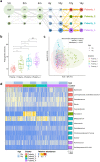Development of the gut microbiota in the first 14 years of life and its relations to internalizing and externalizing difficulties and social anxiety during puberty
- PMID: 37071196
- PMCID: PMC10894087
- DOI: 10.1007/s00787-023-02205-9
Development of the gut microbiota in the first 14 years of life and its relations to internalizing and externalizing difficulties and social anxiety during puberty
Abstract
Relations between the gut microbiota and host mental health have been suggested by a growing number of case-control and cross-sectional studies, while supporting evidence is limited in large community samples followed during an extended period. Therefore, the current preregistered study ( https://osf.io/8ymav , September 7, 2022) described child gut microbiota development in the first 14 years of life and explored its relations to internalizing and externalizing difficulties and social anxiety in puberty, a period of high relevance for the development of mental health problems. Fecal microbiota composition was analysed by 16S ribosomal RNA gene amplicon sequencing in a total of 1003 samples from 193 children. Through a clustering method, four distinct microbial clusters were newly identified in puberty. Most children within three of these clusters remained in the same clusters from the age of 12 to 14 years, suggesting stability in microbial development and transition during this period. These three clusters were compositionally similar to enterotypes (i.e., a robust classification of the gut microbiota based on its composition across different populations) enriched in Bacteroides, Prevotella, and Ruminococcus, respectively. Two Prevotella 9-predominated clusters, including one reported by us earlier in middle childhood and the other one in puberty, were associated with more externalizing behavior at age 14. One Faecalibacterium-depleted pubertal cluster was related to more social anxiety at age 14. This finding was confirmed by a negative cross-sectional relation between Faecalibacterium and social anxiety in the 14-year-olds. The findings of this study continue to map gut microbiota development in a relatively large community sample followed from birth onwards, importantly extending our knowledge to puberty. Results indicate that Prevotella 9 and Faecalibacterium may be relevant microbial taxa in relation to externalizing behavior and social anxiety, respectively. These correlational findings need validations from other similar cohort studies, as well as well-designed mechanistic pre-clinical investigations before inferring cause and effect.
Keywords: Externalizing behavior; Faecalibacterium; Gut microbiota development; Prevotella 9; Puberty; Social anxiety.
© 2023. The Author(s).
Conflict of interest statement
Y.O., C.B., H.S., and C.deW declare that they have no conflicts of interest.
Figures

Similar articles
-
Gut microbiota and child behavior in early puberty: does child sex play a role?Gut Microbes. 2023 Dec;15(2):2278222. doi: 10.1080/19490976.2023.2278222. Epub 2023 Nov 9. Gut Microbes. 2023. PMID: 37943628 Free PMC article.
-
Development of the gut microbiota in healthy children in the first ten years of life: associations with internalizing and externalizing behavior.Gut Microbes. 2022 Jan-Dec;14(1):2038853. doi: 10.1080/19490976.2022.2038853. Gut Microbes. 2022. PMID: 35188073 Free PMC article.
-
Sexual dimorphism of gut microbiota at different pubertal status.Microb Cell Fact. 2020 Jul 28;19(1):152. doi: 10.1186/s12934-020-01412-2. Microb Cell Fact. 2020. PMID: 32723385 Free PMC article.
-
Diet, gut enterotypes and health: is there a link?Nestle Nutr Inst Workshop Ser. 2013;77:65-73. doi: 10.1159/000351385. Epub 2013 Aug 29. Nestle Nutr Inst Workshop Ser. 2013. PMID: 24107497 Review.
-
Is a vegan or a vegetarian diet associated with the microbiota composition in the gut? Results of a new cross-sectional study and systematic review.Crit Rev Food Sci Nutr. 2020;60(17):2990-3004. doi: 10.1080/10408398.2019.1676697. Epub 2019 Oct 21. Crit Rev Food Sci Nutr. 2020. PMID: 31631671
Cited by
-
The saNeuroGut Initiative: Investigating the Gut Microbiome and Symptoms of Anxiety, Depression, and Posttraumatic Stress.Neuroimmunomodulation. 2025;32(1):1-15. doi: 10.1159/000542696. Epub 2024 Nov 19. Neuroimmunomodulation. 2025. PMID: 39561720 Free PMC article.
-
Taxonomic and metabolic development of the human gut microbiome across life stages: a worldwide metagenomic investigation.mSystems. 2024 Apr 16;9(4):e0129423. doi: 10.1128/msystems.01294-23. Epub 2024 Mar 5. mSystems. 2024. PMID: 38441032 Free PMC article.
-
Distinct fecal microbial signatures are linked to sex and chronic immune activation in pediatric HIV infection.Front Immunol. 2023 Aug 29;14:1244473. doi: 10.3389/fimmu.2023.1244473. eCollection 2023. Front Immunol. 2023. PMID: 37711620 Free PMC article.
-
The associations between gut microbiota and fecal metabolites with intelligence quotient in preschoolers.BMC Microbiol. 2024 Oct 25;24(1):431. doi: 10.1186/s12866-024-03579-9. BMC Microbiol. 2024. PMID: 39455934 Free PMC article.
-
Gut microbiota and child behavior in early puberty: does child sex play a role?Gut Microbes. 2023 Dec;15(2):2278222. doi: 10.1080/19490976.2023.2278222. Epub 2023 Nov 9. Gut Microbes. 2023. PMID: 37943628 Free PMC article.
References
MeSH terms
Grants and funding
LinkOut - more resources
Full Text Sources

